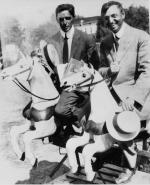Buchman was full of apparent contradictions. An ardent advertiser of his own activities, he was also surprisingly self-effacing; the product of a conservative and cautious religious tradition, he was strikingly radical in his methods; extrovert in manner, he was at heart profoundly reserved.
His work, too, was full of paradoxes. He concerned himself with the intimate details of people's lives yet encouraged them to have a global perspective: 'Think in continents,' he told students, although his own experience was so far limited to two.*

(* cf. Major Gordon Heron (Penn State 1915) to Buchman, 20 May 1932: '1 well remember how you used to tell us to "think in continents" and be a "world power"…. It seems to me you have achieved what you used to advise for us'.)
In the same way, although he was at grips with the deepest human emotions, his work bore none of the marks of extravagant revivalism. 'As I have witnessed it,' wrote Blair Buck later, '(it) is not at all of the emotional variety characteristic of Billy Sunday or Aimee Semple Macpherson.'28
Those seven years in Penn State provided Buchman with a multitude of stories which he used for the rest of his life. He was no preacher. Where others used emotion or the fear of hell-fire, Buchman used stories. These encouraged the hearer to feel that if people like Bill Pickle, Blair Buck and Dean Agee could become different, then it was possible for anyone. He was a master raconteur, and people frequently said that a story which took him an hour to tell flashed by like ten minutes. Critics attributed this method to egotism, since - particularly in the early years - they were generally stories in which he had himself featured: it was only as others began to work with him that the stories as frequently centred around the adventures of others. Buchman used them in an age before films or television, to leave vivid pictures in people's minds.
44
Photo: Blair Buck (left) vacationing with Buchman in Minnesota, 1912.
©Buchman Archive/MRA Productions/MRA Productions